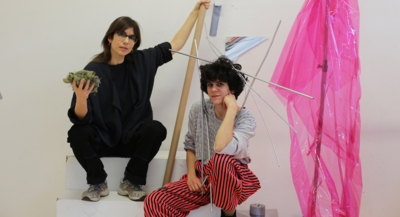Strange Mountains and Creatures of Hope

Miriam Jakob and Lee Méir studied together at the HZT (Hochschulübergreifendes Zentrum Tanz Berlin) until 2013 and have been friends and colleagues in the independent Berlin dance scene ever since. Now, for tanzraumberlin, they have started sending letters to each other. They share their thoughts on the role of art in society and what it means to be a contemporary choreographer today. They write about the critical potential and the healing power of making art, and of course about their own work: both will be showing a new solo work from May 23 to 25 at Uferstudios.
TEXT: Miriam Jakob und Lee Méir
Miriam Jakob — choreographer, performer and artist researcher & Lee Méir — choreographer, performer and costume designer
Dear Miri,
I’m diving into contemporaneity and checking what Google says: “occurring/existing at the same time period, the quality of being current or of the present”. Good start?
The first idea makes me think about our unlimited access to information seemingly connecting us to everything worldwide all the time. It’s daunting to be continuously exposed to everything especially when much of it isn’t embodied. Coping with this paradox drives us to try to solve it. But maybe that’s the truth of our times — being with this intolerability. As for the second idea, I think performance embodies the quality of the present — it exists briefly, then vanishes. This ephemerality is a reason I make performances; they anchor us in a hyper-intense, shared physical present. Yet, there’s also the less romantic aspect to this idea, which is constantly negotiating relevance and innovation within the art field and market.
I realize that in crying creatures crying I try to challenge ‘being relevant’, specifically the pressure to articulate art’s validation through language and logic. We’re living in a moment where language has become a kind of weapon and simultaneously, amidst numerous catastrophes, it often fails. In this solo, I distance myself from language and literal meaning, and seek a strangeness that needs abstraction to crystallize and invent its own system of meaning.
Returning to the idea of solving intolerability, the Western art world emphasizes art’s role as a societal critic, solidifying its position by addressing ‘real issues.’ I do think art should critique its context, but I think it has a broader job to expand minds and hearts beyond the immediate. The art world’s attempt to control art suffocates it. Furthermore, the euro-centric idea of art solely as a critique of society can inadvertently reinforce selfaffirmation rather than self-reflection. I advocate for art that engages with its times while transcending them.
One more thing — these past months have been difficult. Dancing has been a true friend to me.
During our last conversation, you mentioned the importance of time in your new solo. Tell me more?
Yours, Lee
Dear Lee,
thank you for initiating this dialogue between us. Writing the words “between us” immediately takes me back to your first performance at HZT, where you repeatedly asked the audience, “Is it working between us?” — Well yes, I think so.
When I spoke to you about the importance of ‘time’ for my new performance Geteilte Echos, (Shared Echos) I had in mind time scales beyond the human realm, particularly geological time and phenomena that occur outside of human perceptibility. How can my ever-changing human body, with its comparatively short life span, resonate with the micromovements and rhythms of a mountain? I am inspired by the vocabulary used in geomorphology to describe landscape evolution phenomena. I ask myself how these concepts correspond with the transformation of my body and the way trauma is stored within it: zones of weakness, cracks, creeping, fragile stability.
I always seek to approach my own perception and understanding from different perspectives and angles. There is this beautiful quote from the Brazilian writer Clarice Lispector: “To interpret and shape myself, I need new signs and new articulations in forms which are found both on this side of my human history and the other.”
Even if this sounds paradoxical, I am interested in performance as a medium to question the common assump-tion or promise of “contemporaneity,” the quality of being present: How can we be present to an event that does not merely address us, as human animals, let’s say?
In these poly-realities, I see the political dimension of my work. I am less concerned with experimenting with different forms of representation, but rather with evoking strangeness — to challenge or distort what I know, what I expect, or what I recognize. Perhaps the quality of seeking strangeness also gives me hope. When perceived certainties begin to falter and belief systems start to tremble, it might be destabilizing for a moment, yet it also gives me hope for how things could be otherwise.
I think there are some things between us, yes, I hope it’s working.
Yours, Miri
Geteilte Echos (Shared Echos) by Miriam Jakob
May 23 – 26, 2024, Uferstudios / Heizhaus
crying creatures crying by Lee Méir
May 24 – 26, 2024, Uferstudios / Studio 14